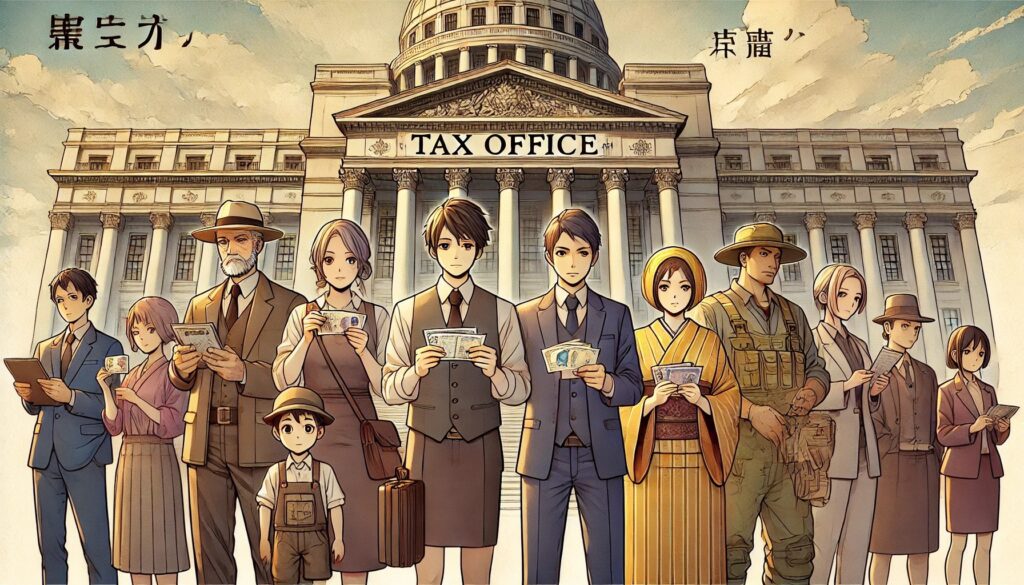This article provides an in-depth analysis of the relationship between government financial management and inflation control, focusing on Modern Monetary Theory (MMT). MMT is a theory based on the idea that as long as a government can issue its own currency, fiscal deficits are not a problem.
Controlling Inflation with Taxes
Taxes are not a source of government revenue but a tool to control inflation. Tax increases are implemented not to secure financial resources but to manage inflation. It is believed that increasing government spending leads to higher employment and economic activation.
Evaluation of MMT
MMT is a bold theory that overturns the conventional notion that “national debt is bad,” but managing inflation is difficult, so it has not been fully adopted. However, it has influenced recent fiscal policies, although it remains a controversial theory that differs from mainstream economics.
How the Government Creates Money
The government creates money through two methods: currency issuance and government bond issuance. Direct monetary issuance is a form of fiscal finance, but it is prohibited by Japanese fiscal law. On the other hand, issuing government bonds is a means of raising funds through the market and is a primary financial management tool. This allows the government to stabilize the economy through policy implementation, but as a result, the national debt continues to grow.
Kuroda Bazooka
Inflation can be beneficial for economic growth if kept at a moderate level, but if left uncontrolled, it can destabilize the economy. The large-scale monetary easing policy known as the “Kuroda Bazooka” led to yen depreciation and stock price increases but did not generate the expected level of inflation.
Wages Did Not Rise
One reason for this was that large corporations benefiting from the weaker yen accumulated foreign profits but did not use them to raise workers’ wages, instead increasing internal reserves. Additionally, consumption tax hikes reduced household disposable income, suppressing consumption.
Changes in Consumer Mindset
Years of deflation made consumers cautious, causing them to hold back on spending even when prices rose. As a result, while the wealthy benefited from rising stock prices, the general population suffered from stagnant wages and tax burdens, exacerbating economic inequality.
Government Bonds as Debt That Doesn’t Need Repayment
The government issues bonds under the guise of “debt” to maintain fiscal discipline and market trust. However, government bonds are effectively rolled over with new issuances, making them debt that does not need repayment. Moreover, inflation reduces the real value of government bonds, creating a favorable situation for the government.
The Ministry of Finance Will Not Stop Issuing Bonds
The Ministry of Finance has no intention of reducing or repaying government bonds. The system allows for perpetual debt rollover, effectively enabling unlimited issuance. However, schools continue to teach students that “Japan is in serious debt,” misleading the public into believing a crisis exists.
The Reality of Consumption Taxes
Tax increases are commonly framed as a means of securing revenue, but from an MMT perspective, their primary purpose is to control inflation. While adjusting consumption taxes might seem like an effective inflation management tool, in reality, it carries significant risks.
2019 Consumption Tax Hike
In 2019, then-Prime Minister Abe stated that tax hikes would proceed unless an economic crisis of the scale of the Lehman Shock occurred. However, the following year’s COVID-19 pandemic had an even greater impact on the global economy.
Evaluation of Abenomics
The consumption tax increase was likely agreed upon with the Ministry of Finance, but without it, Abenomics might have been more favorably evaluated. In particular, raising the consumption tax before the full benefits of monetary easing were realized suppressed domestic demand, ultimately slowing economic growth.
Failure to Control Inflation
Japan has suffered economic stagnation for over 30 years and has failed to implement effective inflation control. While yen depreciation has driven up prices, wages have remained stagnant, causing financial hardship for many citizens.
Disposable Labor and Growing Poverty
Yen depreciation should ideally boost export industry profits, leading to wage increases. However, the rise of non-regular and gig economy jobs has worsened poverty among young people.
Widening Wealth Gap
Policies like Abenomics and the Kuroda Bazooka benefited the wealthy, while ordinary people were forced to adopt a more frugal mindset due to rising living costs. This has led to increased economic disparity in Japan.
Understanding government fiscal operations and financial policies is crucial in making informed decisions. While moderate inflation control is necessary, individuals must assess government policies and adapt their financial strategies accordingly.
- Controlling Inflation with Taxes
- Evaluation of MMT
- How the Government Creates Money
- Kuroda Bazooka
- Wages Did Not Rise
- Changes in Consumer Mindset
- Government Bonds as Debt That Doesn’t Need Repayment
- The Ministry of Finance Will Not Stop Issuing Bonds
- The Reality of Consumption Taxes
- 2019 Consumption Tax Hike
- Evaluation of Abenomics
- Failure to Control Inflation
- Disposable Labor and Growing Poverty
- Widening Wealth Gap
- What is MMT (Modern Monetary Theory)?
- How the Government Creates Money
- Why Does Inflation Occur?
- Case Study: The Kuroda Bazooka
- Why Does the Government Issue Bonds?
- Meaning of Tax Increases and the Reality of Politics and Corporations
- Conclusion: Inflation Control Is the Key
What is MMT (Modern Monetary Theory)?
MMT (Modern Monetary Theory) is an economic theory that argues that as long as a government can issue its own currency, fiscal deficits are not a problem. It was proposed in the 1990s by Warren Mosler and later developed by economists such as Stephanie Kelton.
Claims and Benefits of MMT
MMT argues that governments do not need to fear fiscal deficits, as debts denominated in their own currency cannot theoretically lead to bankruptcy as long as the central bank can issue money. Taxes are not a source of government revenue but a tool for controlling inflation. Tax hikes are implemented not to secure financial resources but to manage inflation. Increasing government spending is believed to boost employment and stimulate economic growth.
Disadvantages and Criticism of MMT
MMT is criticized for the risk of uncontrollable inflation. Unlimited money printing could lead to hyperinflation. There is also a risk of losing market trust—if the government issues too many bonds, confidence in the currency could decline, leading to extreme depreciation. Additionally, MMT could undermine the independence of the central bank, as excessive government control over money issuance may hinder effective monetary policy management.
Is MMT Well-Evaluated?
MMT is a bold theory that overturns the conventional view that ‘national debt = bad,’ but it has not been fully adopted due to the difficulty of managing inflation. However, it has undoubtedly influenced recent fiscal policies, even though it differs from mainstream economics and remains a topic of debate.
Conditions where MMT is more likely to succeed include having sufficient labor market slack, allowing government spending to reduce unemployment and stimulate economic growth. Additionally, if domestic production capacity is high enough to meet rising demand, inflation can be kept under control. Historical examples, such as the New Deal in the U.S. and Japan’s post-war economic boom, demonstrate how government-led fiscal spending contributed to economic growth. However, if supply capacity is insufficient and excessive government spending continues unchecked, inflation can spiral out of control, destabilizing the economy.
How the Government Creates Money
The government primarily funds its expenditures through two methods: ‘currency issuance’ and ‘government bond issuance.’
Currency issuance (fiscal finance) involves the central bank directly providing funds to the government, but this is prohibited under Japan’s Fiscal Law Article 5. Historical cases, such as wartime Japan and the Weimar Republic, show that this approach can lead to hyperinflation.
On the other hand, government bond issuance (market-based funding) involves the government issuing bonds, which are purchased by banks and investors. The Bank of Japan then indirectly supports these bonds by purchasing them from the market, effectively supplying funds to the government in a legally permissible manner.
Why Does Inflation Occur?
The government issues money, creates jobs, and pays wages, allowing people to consume and keep the economy running. However, while it may seem that an unlimited supply of money can sustain spending indefinitely, in reality, production capacity has limits. For instance, if a bakery can produce 100 loaves of bread per day but 150 customers arrive, 50 of them will not be able to buy. If these customers are willing to pay 1.5 times the regular price, prices rise, leading to inflation.
Taxes as a Means to Control Inflation
In such situations, the government can impose taxes to return excess revenue and regulate the flow of money. Specifically, increasing consumption taxes or income taxes reduces disposable income, curbing spending. As a result, demand declines, slowing the momentum of rising prices.
In other words, even if people receive wages, the amount of money they can freely spend is reduced due to taxation, weakening the momentum of consumption and suppressing excessive demand. As a result, the number of people willing to pay 1.5 times the normal price for bread decreases, ultimately curbing the progression of severe inflation.
Case Study: The Kuroda Bazooka
In 2013, under the leadership of Bank of Japan Governor Haruhiko Kuroda, the “Quantitative and Qualitative Monetary Easing (QQE)” policy had a significant impact on the Japanese economy. Aimed at achieving a 2% inflation target, the policy involved large-scale government bond purchases to supply money and ETF (Exchange-Traded Fund) acquisitions to support stock prices. As a result, the yen depreciated from 80 yen to 120 yen per US dollar. Additionally, stock prices soared, with the Nikkei 225 Index rising from 9,000 yen to over 20,000 yen.
However, the expected level of inflation did not materialize. One reason for this was the insufficient increase in wages. Japanese companies increased their internal reserves while avoiding significant wage hikes for workers.
Additionally, prolonged deflation altered consumer sentiment. Particularly among younger generations, disposable income did not increase, leading to more cautious spending behavior, which in turn suppressed price increases.
Furthermore, the final blow came from the impact of consumption tax hikes. The tax rate increases in 2014 and 2019 increased the financial burden on consumers, leading to reduced spending. This suppressed domestic demand and hindered the momentum of price increases.
These factors combined, preventing the monetary easing policies of the Kuroda Bazooka from generating the expected level of inflation.
Why Does the Government Issue Bonds?
One of the advantages of issuing government bonds is that it allows the government to maintain the facade of ‘debt.’ Government bonds are said to be ‘repaid eventually,’ but in reality, they are continuously rolled over through the issuance of new bonds, making repayment practically unnecessary.
Additionally, it creates the appearance of fiscal discipline. Direct money printing can lead to a loss of market confidence, whereas issuing bonds gives the impression that financial markets are functioning properly.
‘Debt’ That Does Not Need Repayment in Practice
Government bonds are continuously rolled over upon maturity by issuing new bonds. In other words, they constitute debt that does not need to be repaid in practice. This is the key difference between typical debt and government bonds. Additionally, interest payments on bonds held by the Bank of Japan ultimately return to the government, effectively canceling out the debt.
Furthermore, if inflation progresses, the real value of debt decreases. For example, if the inflation rate remains at 2% per year, the price level after 20 years will be approximately 1.49 times higher. As a result, the current debt of 1,000 trillion yen will be effectively reduced to about 670 trillion yen in today’s price level. This is due to the economic mechanism where inflation reduces the value of money, meaning that even if the nominal amount of debt remains unchanged, the actual burden decreases.
One-Time Debt Repayment for Convenience
As the accumulation of government bonds is increasingly scrutinized, an extreme solution has been suggested: “Why not have the government issue 1,000 trillion yen in new currency and use it to repay all government bonds?” At first glance, this may seem like a reasonable approach since the government would directly issue money to eliminate its debt. However, such a policy would flood the market with a massive supply of money at once, potentially triggering rapid inflation. Historical cases have shown that excessive money issuance has often led to hyperinflation. The same risk exists in Japan’s economic structure, making gradual bond rollovers and controlled inflation a more practical and viable solution.
Meaning of Tax Increases and the Reality of Politics and Corporations
Tax increases are often explained as a means to secure financial resources, but in reality, one of their primary purposes is inflation control. According to MMT, the government does not need to rely on tax revenue as a financial resource, nor does it need to fear fiscal deficits. Therefore, the main role of tax increases is to curb excessive demand caused by an oversupply of money and to control price inflation. In particular, consumption tax hikes reduce consumers’ disposable income, thereby limiting spending and reducing inflationary pressure on the market. Additionally, raising income taxes and corporate taxes affects spending behavior in businesses and individuals, acting as a tool to control economic overheating. In this way, tax increases are not just about balancing fiscal accounts but serve as a policy tool for maintaining economic balance between supply and demand.
Corporate Restructuring Success = Higher Executive Pay
In the past, it was common for executives responsible for restructuring to leave the company last, but nowadays, a reverse phenomenon has emerged where “the more successful a restructuring is, the higher the executive compensation.” As a result, the burden of restructuring always falls on lower-level employees.
The Same Structure Applies to Politics
A similar structure is seen in politics. While politicians push for tax increases and fiscal austerity, discussions on reducing parliamentary salaries or the number of legislators are rarely held. There is public sentiment that if citizens must bear the burden of tax increases, politicians should also feel the impact first, but such measures are rarely implemented.
Additionally, within the Ministry of Finance, those who successfully implement tax hikes are often regarded as successful officials. Since reducing fiscal deficits is seen as a key governmental responsibility, bureaucrats and politicians who increase tax revenue through tax hikes are often highly evaluated within the organization. As a result, there is a deeply ingrained belief within the Ministry of Finance that pushing for tax increases contributes to “fiscal soundness.”
However, for ordinary citizens, increased tax burdens can make daily life more difficult. Consumption tax hikes, in particular, disproportionately impact lower-income groups. Despite this, tax increases are considered a success from the perspective of fiscal management because of the entrenched belief that “eliminating fiscal deficits ensures national stability.”
One of the biggest reasons why the effects of the Kuroda Bazooka monetary policy did not benefit the general public was undoubtedly the impact of consumption tax increases. The Ministry of Finance’s tax policies have sometimes been sarcastically referred to as “Zaibatsu Theology”. This belief system is based on the conviction that reducing fiscal deficits is the path to national stability, making tax hikes their highest priority.
However, for the average citizen, this reasoning is difficult to understand. The bureaucrats at the Ministry of Finance may even believe that their logic is beyond the comprehension of ordinary people. As a result, their policies often become disconnected from real-life economic conditions, with consumption tax hikes dampening spending and negating the effects of monetary easing.
The Government Has No Intention of Reducing National Debt
Upon closer examination, it becomes clear that the government has no real intention of pursuing fiscal consolidation. In reality, the government has “no reason to reduce bond issuance.” Government bonds are the foundation of the national budget, and the same structure applies to supplementary budgets. Although bonds are frequently referred to as “debt,” the government neither plans to repay them nor reduce their issuance.
Despite this, Japanese citizens are taught from elementary school that “Japan is drowning in debt and in a dire situation.” This is an extraordinary narrative. In reality, the government is not only avoiding debt reduction but is actively continuing and expanding its bond issuance.
Conclusion: Inflation Control Is the Key
The ideal government strategy is to continue issuing bonds while maintaining “moderate inflation.” As inflation progresses, the real burden of debt decreases, making repayment less significant. Additionally, tax increases are often implemented not for securing financial resources but for inflation control.
Both in the corporate and political spheres, the structure has become one where “those at the top do not bear the burden,” and the public needs to recognize this reality. Government debt is “practically nonexistent,” but this only holds true “as long as moderate inflation is maintained.” The ability of the government to control inflation is the key to everything.
Japan has experienced over 30 years of economic stagnation, and it is difficult to say that inflation control has been properly managed. The current inflation trend is not driven by domestic demand expansion but rather by cost-push factors, such as a weak yen leading to higher raw material costs. While export companies benefiting from a weak yen enjoy gains, domestic demand is significantly affected by rising costs, particularly in essential goods and energy. Given this situation, implementing tax reductions and striking a balance between inflation and economic growth is a necessary policy shift.
Prioritizing fiscal consolidation while suppressing consumer spending will not lead to sustainable economic growth. The key to achieving a stable inflationary environment lies in appropriate tax reductions and fiscal spending adjustments to restore consumer purchasing power.
The Lack of Benefits for Ordinary Citizens
The most notable impact of Abenomics and the Kuroda Bazooka was in the stock market, benefiting asset holders, particularly the wealthy. Meanwhile, many ordinary citizens adapted to a deflationary environment, reinforcing a “savings-oriented” mindset due to stagnant wages. Companies also adjusted to prolonged deflation by shifting toward business models that relied heavily on price competition.
While the wealthy expanded their assets through rising stock and real estate prices, the general public, who did not participate in financial investments, saw little benefit. For example, the Nikkei 225 index rose from 9,000 yen in 2012 to over 30,000 yen in 2024. However, those who did not invest in stocks did not experience these gains, and instead, wealth disparity widened. “Those with financial assets became wealthier, while those without continued seeking cheaper goods.” This was one of the greatest tragedies of Japan’s deflation era.
Moreover, even as the yen depreciated, the general public did not feel the benefits. Ideally, a weaker yen would lead to “a boost in exports → increased corporate profits → higher wages.” However, companies accumulated profits as internal reserves rather than distributing them as higher wages. Meanwhile, rising import prices directly impacted household finances. Particularly after 2020, inflation combined with a weak yen caused food and energy prices to soar. Since wages did not increase, households had no choice but to adopt a more frugal lifestyle.
Thus, while the Kuroda Bazooka’s monetary easing policies benefited asset holders, the lack of wage growth meant that ordinary citizens saw few advantages. Instead, these policies contributed to widening economic inequality.
There is no point in contemplating “what if” scenarios in history. However, it is possible to learn from past experiences to make better choices for the future. While it may be difficult for the voices of ordinary citizens to directly influence government monetary policy, understanding economic mechanisms and optimizing individual financial decisions is within our control. By carefully observing economic trends and making informed decisions, each individual can contribute to a more prosperous future.











